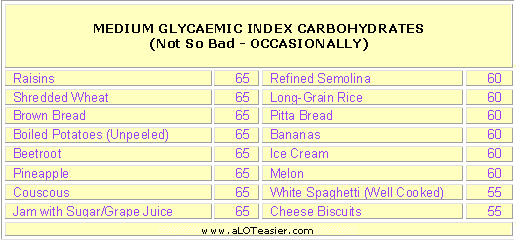

THE GI DIET(Glycaemic Index)
Rather than cutting out carbohydrates, the trick is to eat the right ones. The reason for this is that, although carbohydrates break down to provide blood glucose, they don't all do it at the same rate. It depends on their Glycaemic Index. This Index is based on a ranking from 1 to 100. The foods that break down the slowest have the lowest GI - these gradually release glucose and therefore leave you feeling satisfied for longer. At the other end of the scale there are the carbohydrates which break down quickly, raising blood sugar levels rapidly. These then come crashing down again, leaving you with food cravings. There seem to be other benefits too, healthier blood sugar and fat levels and also the possibility that it may reduce the risk of type 2 diabetes, heart disease and certain cancers.  One final thought. The bottom line is always this - you only lose weight if you eat fewer calories than you burn. SO WATCH THOSE PORTION SIZES! and get plenty of exercise.
For a guide to the glycaemic index of some common foods see below.
   
Copyright © 2004 aLOTeasier.com. All Rights Reserved.
|














